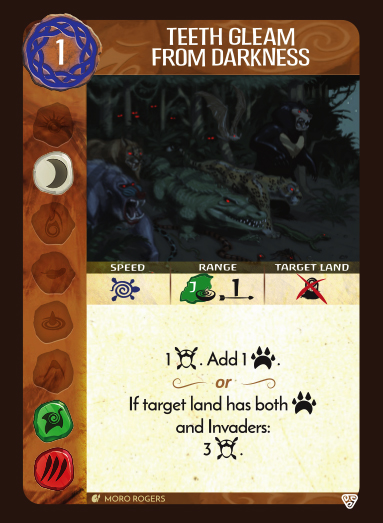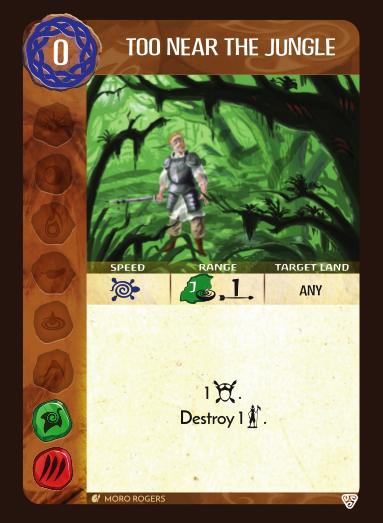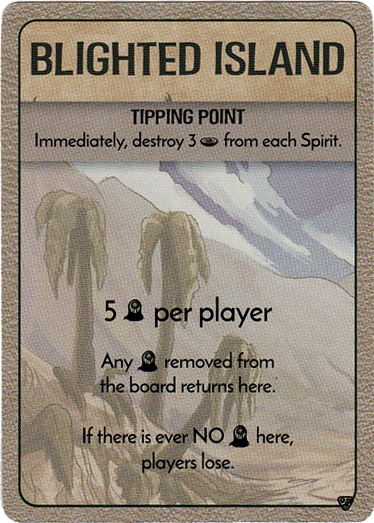[Sharp Fangs Behind the Leaves] General Concepts
Growth
Fangs’ growth is extremely versatile. Consider the following second-growth choices over two turns (the first growth being G2 to place presence):
- G3 > G3, which grants +2 cards and +2 Energy;
- G4 > G1, which grants +1 card, +2 Energy and a reclaim;
- G3 > G1, which grants +2 cards and a reclaim.
These options give a mix of Energy, extra cards, and reclaim. When writing an opening, a specific growth option is recommended, but it could often be swapped for another one according to needs.
For example, G3 > G3 can be swapped for G4 > G1 if reclaiming cards is more valuable than gaining an extra Power. This can be used to activate Ranging hunt by playing Teeth gleam
by playing Teeth gleam and Too near the jungle
and Too near the jungle on the first turn if taking the presence from the top track, and still have access to them in the next couple of turns thanks to reclaiming cards; the cost to pay is one Minor gain, which will be detrimental in the long run, thus exchanging long-term benefits for an early Ranging hunt
on the first turn if taking the presence from the top track, and still have access to them in the next couple of turns thanks to reclaiming cards; the cost to pay is one Minor gain, which will be detrimental in the long run, thus exchanging long-term benefits for an early Ranging hunt .
.
Presence conversion
Presence should be converted as much as possible into Beasts, ideally every turn outside of maybe one or two, as typically only 2-3 presence on the island is needed (or 4 presence to avoid instant loss by Tipping Point if you’re still using it).
if you’re still using it).
Beasts placement
Beasts placement is the single most important aspect of playing Fangs, as you need Beasts to place presence outside of Jungles, to use your Innates, to move your presence, and to use two of your Uniques (Prey on the builders and Terrifying chase
and Terrifying chase ) effectively. Because of this, the movement threshold of Ranging hunt
) effectively. Because of this, the movement threshold of Ranging hunt is just as important as the damage part, as it sets up future actions.
is just as important as the damage part, as it sets up future actions.
Generally speaking, you want to spread your Beasts as much as possible, but also having them concentrated in lands that you want to hit hard with Ranging hunt . The balance varies depending on board state and Adversary. For example, against England small Ranging hunt
. The balance varies depending on board state and Adversary. For example, against England small Ranging hunt are ineffective, so it’s often preferrable to have fewer lands with more Beasts to use it on.
are ineffective, so it’s often preferrable to have fewer lands with more Beasts to use it on.
It’s particularly useful to have one Beasts in lands with blight, so that you can easily add a Presence and use Prey on the builders to keep the land under control whenever needed.
to keep the land under control whenever needed.
Having a Beasts in a land also means that you can easily get 2 more Beasts to do damage with Ranging hunt (1 from presence conversion and 1 from the Gather threshold), thus being able to deal 3+ damage as opposed to the 1 damage you can do if the land doesn’t start with any Beasts (as you can only Gather 1).
(1 from presence conversion and 1 from the Gather threshold), thus being able to deal 3+ damage as opposed to the 1 damage you can do if the land doesn’t start with any Beasts (as you can only Gather 1).
Energy
Energy management can be tricky with Fangs: your Reclaim growth has an Energy cost, plus it takes a few turns to unlock the 2 Energy/turn spot, which means that more often than not you won’t unless going for Majors. You will have to use your G4, but be aware that you won’t be able to consistently use it until the late game (unless you delay placing presence, which is usually bad), so you’ll need to spread the 3 Energy over 2 or 3 turns.
Minors selection
If you go top track (unlocking ![]() and
and ![]() ), the only requirement for activating Ranging hunt
), the only requirement for activating Ranging hunt every turn from the 2nd onwards is to find 1
every turn from the 2nd onwards is to find 1 ![]() Minor. If you instead only unlock
Minor. If you instead only unlock ![]() and then go bottom track, prioritise getting 1
and then go bottom track, prioritise getting 1 ![]() Minor. After that, elements cease being as much of a priority, as high card plays and the possibility to reclaim Too near the jungle
Minor. After that, elements cease being as much of a priority, as high card plays and the possibility to reclaim Too near the jungle every turn give a lot of flexibility with elements.
every turn give a lot of flexibility with elements.
Blight handling is excellent on Fangs, and it’s worth prioritising it over better Elements (plus such Powers often grant ![]() anyway).
anyway).
Reclaim 1
Too near the jungle should probably be the Power you reclaim most often after you uncover the Reclaim 1 spot on your bottom track, because it has great elements for Ranging hunt
should probably be the Power you reclaim most often after you uncover the Reclaim 1 spot on your bottom track, because it has great elements for Ranging hunt while costing 0. Energy is especially tight if going bottom track, but even when going top track you don’t have much to spare, so it’s better to avoid reclaiming Teeth gleam
while costing 0. Energy is especially tight if going bottom track, but even when going top track you don’t have much to spare, so it’s better to avoid reclaiming Teeth gleam or other 1-cost Powers if possible.
or other 1-cost Powers if possible.